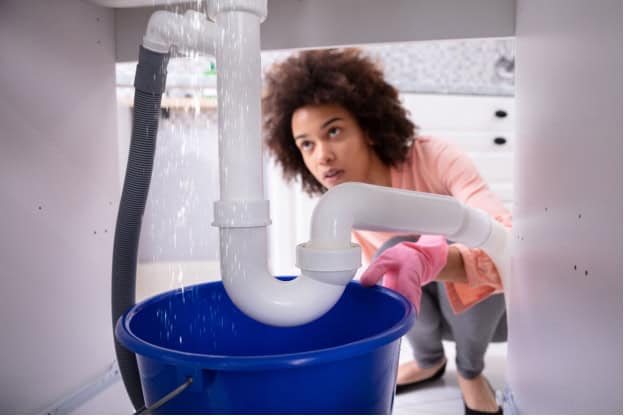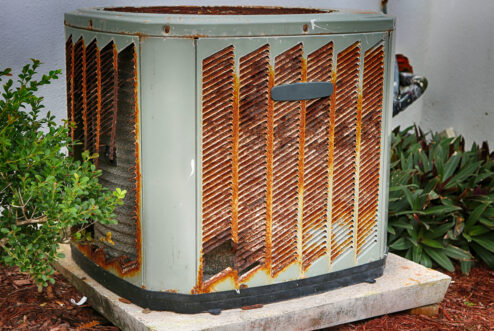While your plumbing system is a necessary part of your daily routine in your home, it’s easy to forget about it. That is, until an emergency happens.
Plumbing problems are often part of homeownership, but among the worst is a sudden pipe leak. Minor leaks can be a quick and easy fix, but if they lead to a burst, you could deal with expensive repairs, significant water damage, and a lot of disruption to your day-to-day routine.
When plumbing emergencies strike, Southern California homeowners rely on Timo’s Air Conditioning & Plumbing to help. With decades of experience under our belt and an unrivaled commitment to your satisfaction, we’ll get your problem fixed with friendly, expert service.
Though you want professional help during a plumbing emergency, you can minimize the damage in the meantime. Here’s everything you need to know to handle a sudden plumbing leak while you wait for help to arrive.
What Are the Signs of a Pipe Leak?
According to the Environmental Protection Agency (EPA), leaking pipes waste about 1 trillion gallons of water each year. Unfortunately, leaking pipes are easy to miss until they become a major problem – wasting money and damaging your home in the process.
Here are the warning signs of a pipe leak:
High Water Bills
It’s common to see fluctuations in your water bill throughout the year. For example, water bills may rise in the summer if you’re running sprinklers, maintaining a pool, or watering a garden regularly. But if you see a sudden spike in your bill without an apparent cause, that could be a leaking pipe.

Pipe leaks often start small, leading to incremental increases in your water bill each month. However, a bigger leak could leave you with a much higher bill suddenly. Keep an eye on your water company’s comparison chart, which shows your usage, to quickly identify a potential problem.
Visible Mold or Mildew
A little mold and mildew is bound to happen in moist areas, such as the shower, no matter how clean you keep your home. However, if you see mold outside of the bathroom, such as on your walls, baseboards, ceilings, or floors, that could indicate a leaking pipe.
Musty Smells
You may not notice the signs of water damage quickly, but smells can be a giveaway. Mold and mildew inside your walls, vents, or under your floors will have a distinctive odor you may recognize.
If you have musty smells in areas that aren’t exposed to a lot of moisture, such as your main living areas, it could be from water pooling in one area under a leaking pipe.
Stained and Damaged Areas
Water damage often starts with subtle signs, such as a dingy looking area on a white ceiling or a water mark on a wall. Don’t ignore these, as they can indicate that something is happening under the surface.
Over time, the damage will only worsen – increasing your repair bills. Worse yet, continuous water flow can eventually compromise your home, leading to a collapsed ceiling or rotting floors.
Wet Spots

Wet spots along your outer walls when there’s been no rain could mean a pipe is leaking inside the wall. You may see wet spots inside your home as well, which could be accompanied by mold and mildew.
Foundation Cracks
All homes settle over time, causing hairline cracks in the ceiling or drywall. However, a sudden crack that has widened, this could be a leaking pipe causing water to flow and damage your home’s foundation. Eventually, your foundation will sink, tearing up the doors, windows, walls, and floors in the process.
What to Do for a Pipe Leak
If you notice the signs of a pipe leak, you have to act quickly to minimize the damage. Here are the steps to follow:
1. Shut Off the Water Supply
If you suspect a leaking pipe, shut off the water supply immediately. You should know where your main water valve is, which is usually in the basement or outside by the water meter. If you don’t already know how to locate your main water supply quickly, make sure to find out before a problem occurs. When you find the main water supply, turn the valve clockwise to shut it off.
2. Drain the Faucets
After the water is shut off (double check!), turn on your faucets in the kitchen, bathrooms, utility room, or anywhere else with a water supply to drain any remaining water from the pipes. This ensures that there’s less water to pool near the leak and damage your home.
3. Turn Off Electricity
If you notice the signs of a leak near electrical outlets or appliances, turn off the electrical supply to the area. Water and electricity don’t mix. If you’re not sure how to cut power to just that area, turn off the electricity supply to your home to ensure it’s safe until help arrives.
4. Collect Water
If the leak is visible, such as from a ceiling, place buckets or containers beneath the leak to collect as much water as possible. While this won’t help the immediate area near the leak, it can prevent water from pooling in your floors and causing more damage.
5. Be Careful with Electricity
If a water leak has come close to electric outlets, switches, or appliances, don’t touch any electrical components until you’re sure the power is off. It’s best to wait until a professional plumber arrives to handle the situation.
6. Find the Leak
Identifying the source of a pipe leak is important for your repairs. Here’s how you can find the leak:

- Look for the water source: Follow the path of water to find out where it’s coming from. Keep in mind that water can travel along pipes, so you may not find a leaking pipe near the obvious signs of water damage.
- Check visible pipes: You can’t see your entire plumbing pipe network, but you can check the exposed pipes to see if they’re leaking. Look under your sinks and check the joints and connections for a leak.
- Look in the basement: Basements are common places for leaks or standing water. Take a look around and see if you can find pools or water, wet spots, or other signs of a leak.
- Check outside pipes: The pipes outside of your home can develop a leak, such as pipes that run to sprinkler systems or pool filters. Check these areas for leaks.
If you can’t find the leak yourself, leave it to the professionals. Plumbers have experience finding pipe leaks and plenty of tools and techniques to pinpoint the exact location.
7. Do Temporary Repairs
Some leaks can be fixed temporarily while you wait for a plumber to arrive. This can minimize the damage from flowing water, but remember that you still need to repair the pipe. These are just temporary solutions.
- Epoxy putty: Epoxy putty can be used to seal small cracks or holes in the pipe. Dry the area first, then apply the putty according to the manufacturer’s instructions.
- Pipe clamps: Pipe clamps and sleeves can cover cracks in the pipes that cause a leak. Make sure you get a clamp that’s the right size for your pipe and secure it.
- Rubber and hose clamps: Rubber and hose clamps can be used to seal a small leak in a pipe temporarily. Place the patch over the leak and secure it with the clamp.
Other Plumbing Emergencies
Leaking pipes are a big problem, but they’re not the only plumbing emergency that can arise. Here are some other problems that can occur and tips to determine if you need an emergency plumber or a regular appointment:
- Burst pipes: Burst pipes are hard to miss and require immediate attention. The signs are similar to a leaking pipe, but often much worse, such as water pouring into your home or spreading across the floor. If a pipe bursts in the wall, you may hear strange sounds. It’s crucial to turn off your water supply and call a plumber for an emergency repair.
- Leaking water heater: If you see rust or puddles around your water heater, hear odd sounds, or have issues with consistent water heat, turn off the water and electricity, then call a plumber as soon as possible. Water heater leaks not only cause water damage, but they can be dangerous.
- Sewer line backup: Sewer line backups have the risk of extensive damage and contamination. You may hear odd noises or smell raw sewage. Avoid using any water in your home and contact a plumber as soon as possible.
- Overflowing toilet: Overflowing toilets are easy to spot. The water levels will rise suddenly, leading to water pouring out of your toilet. Toilets that flush slow are a warning sign of an overflow. Stop the water supply to the toilet and don’t flush. Contact a plumber for a repair.
- Clogged drain: Slow, partially clogged, or completely clogged drains are a nuisance, but they can lead to bigger problems like a burst pipe. Instead of using drain cleaners, contact a professional plumber for an appointment.
Avoid Plumbing Emergencies
While problems like a leaking pipe can strike out of nowhere, you can significantly reduce the likelihood of plumbing emergencies with routine plumbing inspections to spot the warning signs and ensure that your system is running as it should. If you need a plumbing repair or inspection, contact the pros at Timo’s Air Conditioning and Plumbing.



